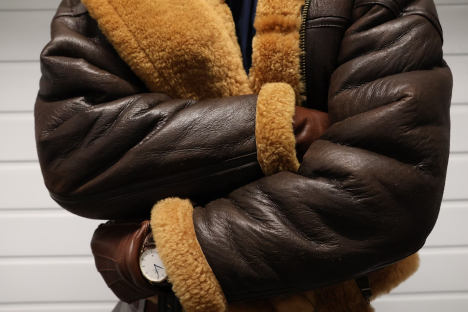Leather has been a staple in women’s fashion for centuries. From jackets to handbags to shoes, it’s a material associated with luxury, durability, and timeless appeal. However, as the fashion industry evolves, so do the ethical concerns surrounding leather production.
The rise of conscious consumerism and sustainability has sparked debate over leather’s environmental and ethical footprint.
Image source: https://www.pexels.com/photo/a-woman-in-black-leather-jacket-wearing-sunglasses-8422523/
Animal Welfare Concerns
One of the most significant ethical issues surrounding leather is its direct link to animal cruelty. Leather is a byproduct of the meat industry, meaning that the animals are often raised for food, and their hides are used to produce leather goods. However, the treatment of these animals during their lives and at slaughterhouses is a major concern.
Practices such as factory farming, lack of adequate space, and inhumane slaughter techniques raise serious ethical questions about the use of animal products in fashion. For many, this is the primary reason to consider alternatives to leather.
Environmental Impact of Leather Production
The environmental impact of leather production is another pressing ethical issue. Tanning leather, the process used to preserve animal hides, requires large amounts of water, chemicals, and energy.
The chemicals involved, such as chromium salts, can contaminate water supplies and harm ecosystems. Additionally, the cattle industry contributes significantly to deforestation, water consumption, and greenhouse gas emissions. The environmental toll of leather production raises concerns for eco-conscious consumers who seek to minimize their ecological footprint.
Water Consumption
Leather production is a highly water-intensive process â large quantities of water are used both in raising livestock for hides and during the tanning process itself. For example, a single cowhide can require over 1,000 gallons of water to produce. As the global demand for leather continues to rise, the pressure on freshwater resources increases, particularly in regions already facing water scarcity.
Chemical Pollution
The tanning process involves the use of chemicals, such as chromium salts, which are harmful to the environment. These chemicals can pollute nearby water sources, leading to contamination of ecosystems and harming wildlife. In some countries, lax environmental regulations allow these toxic substances to be released untreated into rivers, posing long-term risks to public health and biodiversity.
The Rise of Vegan Leather
The growing popularity of vegan leather in women’s fashion highlights a significant cultural shift towards cruelty-free and sustainable choices. Made from innovative materials like pineapple leaves, mushroom roots, and recycled plastics, these alternatives offer a compassionate solution without compromising style or functionality.
For consumers mindful of ethical sourcing, vegan leather provides peace of mind alongside a modern aesthetic. This shift also reflects the broader acceptance of self-expression and identity, especially within intimate fashion spaces. Whether for everyday wear or more personal exploration, like those inspired by a Sissy Chastity lifestyle, choosing vegan leather supports both ethical values and creative freedom. As technology improves, vegan options are becoming more durable and luxurious, making them a thoughtful and progressive alternative in today’s fashion world.
The Pros and Cons of Ethical Leather Brands
Some brands have committed to sourcing leather ethically by prioritizing sustainable practices and animal welfare. These ethical leather companies aim to use hides from animals that are not intensively farmed and often focus on leather from ethical, free-range sources.
They may also invest in eco-friendly tanning processes, such as vegetable tanning, which avoids harmful chemicals. However, even ethical leather raises questions about the true sustainability of using animal products in fashion. Whether these practices are enough to justify leather use in fashion is still debated within the industry.
Fashion’s Shift Toward Sustainability
Fashion’s increasing shift toward sustainability means that leather is no longer the default choice. Designers and consumers alike are exploring alternatives that balance style, durability, and ethical considerations.
From plant-based materials to innovative synthetic options, the fashion industry is evolving to meet the demands of those who seek fashion with a conscience. While leather remains a popular choice, the growing focus on sustainable fashion and ethical materials indicates that the future of women’s fashion may include fewer animal-derived products.
Consumer Responsibility and Choices
As a consumer, you have the power to influence the fashion industry by making informed decisions. The ethical implications of leather are complex, and it’s crucial to consider the environmental and animal welfare aspects before making a purchase.
Supporting brands that align with your values â whether they use ethically sourced leather or sustainable alternatives â can help shift the market toward more responsible practices. Being aware of where and how your leather items are produced can help you make a choice that’s better for the planet and its inhabitants.

Image source: https://unsplash.com/photos/a-close-up-of-a-person-wearing-a-brown-jacket-ZSTRCczhpEU
The ethical implications of leather in women’s fashion are multifaceted, touching on animal welfare, environmental impact, and consumer responsibility. As you make choices about the clothing and accessories you buy, it’s essential to consider the broader consequences of your purchases. While leather has been a symbol of luxury and style for centuries, the industry is slowly moving toward more ethical alternatives. Whether it’s opting for vegan leather or supporting brands committed to sustainable practices, you can play a key role in shaping a more responsible fashion industry.








